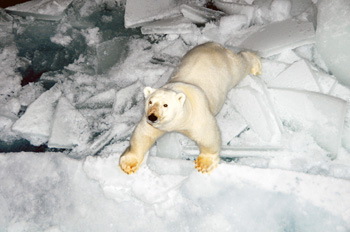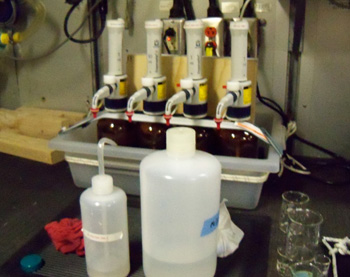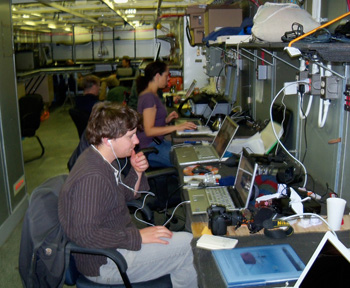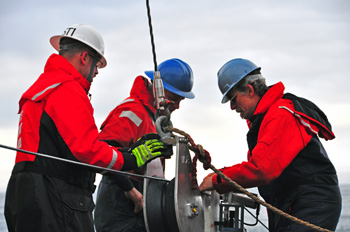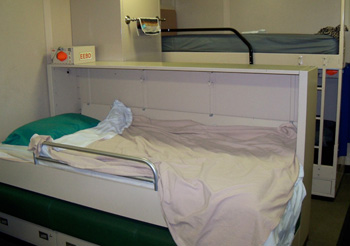Please note: You are viewing
the unstyled version of this website. Either your browser does not support CSS
(cascading style sheets) or it has been disabled. Skip
navigation.
Greetings Morse Pond 5th Graders and Mrs. Buscher, I enjoyed your questions and it's our pleasure to answer them. Hope you continue to enjoy the website. --Pat Keoughan QUESTION 1 HOW THICK CAN THE ICE GET? We had a similar question from the Blakely school which was posted after I received yours. Please check out the answer to their question 6. QUESTION 2 HOW MANY AND WHAT TYPE OF ANIMALS HAVE YOU SEEN? Answered by Pat Keoughan: The 5th graders from Happy Hollow asked about the animals we expected to see in the Arctic so you can refer to their question number 3. I know I saw a weird thing that looked like a white elephant trunk about three feet below the surface of the water. I was told it was a type of jelly called a siphonophore, which is really a collection of many individuals. One member of our group saw two walruses on our second day. Answered by Zachery Brown, Biological Oceanographer: Zooplankton--In the water samples I have been taking out of the CTD rosette, zooplankton have been pretty sparse so far! We did see one single copepod, which looks like a small shrimp with very long antennae. There are probably not a lot of them because there isn't much food around for them. They feed on phytoplankton, which are most abundant in the spring. Phytoplankton need two things to grow: light and nutrients, which are both plentiful in the spring. Now, in the fall, there is still plenty of light (although soon the Arctic will be dark all 24 hours of the day!), but nutrients have been all used up. Ocean mixing processes over the winter will ensure that nutrients are replenished to the surface waters by next spring, but for now, phytoplankton can't grow very well. So, the zooplankton don't have much food around. If phytoplankton can't grow, it affects not just zooplankton, but the rest of the food chain, all the way up to the great whales and seabirds. The whole ecosystem is most productive in the spring.
I've been mostly seeing small flocks of Black-legged Kittiwakes and Short-tailed Shearwaters. These birds are excellent fliers and can forage for food far from their colonies. And I've seen a few Crested Auklets (small chubby birds with a plume on their head like a quail) and Thick-billed Murres (black and white birds that swim with their wings, very similar to penguins except that they can also fly!) Other birds only live close to shore, though, so whenever we go close to land I see Pacific Loons, Red-throated Loons, Long-tailed ducks, and different eiders (large, chunky sea ducks that only live in arctic and subarctic areas). We looked for different animals as we went into the ice on our farthest trip north on September 19th and 20th. The biologists were disappointed that, though we saw several seals, the shy pinnipeds disappeared before we got close enough to identify their species. Brian Hoover, our bird specialist added Glaucus Gulls and Ross Gulls to his list. The exciting discovery for all of us was polar bears! One was observed as it checked out the Healy when we were stopped at 4:00AM. It walked on the ice along the starboard (right) side of the ship. The next day two young juveniles were seen at a distance with many of us watching them through binoculars. QUESTION 3 WHAT IS YOUR FAVORITE PART OF YOUR JOB? Answered by Zach Brown: My favorite part is exactly what I'm doing right now: getting out into the field and experiencing the ocean firsthand. Having grown up in Alaska, I have a great appreciation for the outdoors. Computers and textbooks are very important to my work, but a big part of learning comes from simply being on the ocean. I believe that the ideal way to do science, whether it is biology, chemistry, physics, or even psychology, is to see all the steps: 1) you learn about the system and find out what the interesting questions are, 2) pose a testable hypothesis about it, 3) go into the field and test that hypothesis, 4) go back home and analyze the data to find out what it is telling you, and 5) write up a report about it, so that your peers can find out what you've learned and build upon it. You will have a much greater appreciation and understanding for what you are studying if you participate in all these steps, not just one or two. Still, my favorite part is step 3, getting into the field. No amount of book-learning (although it's very important!) can substitute for getting out seeing the world you study with your own eyes!
Going to sea to collect water samples and deploy oceanographic equipment is one of the favorite parts of my job. Although we can't usually work when its stormy, I love it when the boat gets rocked by the big waves. Looking down from the bridge, or out from a porthole, to see huge crashing waves go by can be a little scary but it's really an awesome sight. There are usually long streaks of foam at the sea surface, lots of spray in the air, crashing breaking waves, and lots of noise from the wind. It gets exciting! But it’s also fun and exciting to discover something new about the ocean from the measurements and share that discovery with others. Good questions, keep them coming! QUESTION 4 CAN YOU EXPLAIN, TECHNICALLY, WHY SKYPE DOESN'T WORK UP THERE? Answered by Dale Chayes, Instrument/Tech. Support: The short answer is that we block Skype in our firewalls. The medium length answer is that we have other, more resource-efficient methods of having voice conversations that allow other, higher priority, uses for our very limited and expensive connection to the Internet. The long answer is: our connection to the Internet is expensive (about $3,500 per month for the service only - technical support and hardware maintenance probably double that cost - so lets say $6,000/month.) For that we get to send or receive about 256,000 bits per second. (One character, letter or number, is 8 bits.)
The highest priority use of our science connection to shore is to get satellite images and data about sea ice and weather conditions which we use to help us plan where and when to go places. Next highest is to keep our science systems, programs, and people connected and operating effectively and efficiently. After that there is some bandwidth available for personal and recreational email. In order to use our science network connection efficiently we pay careful attention to uses and protocols that are efficient and which ones do not make efficient use of our precious bandwidth. We use a special computer on the ship (and another one ashore) to block (prohibit) many kinds of traffic to and from the 'net. Among the things we block are movies, video clips, music, Facebook, and Skype because each of those services uses a large amount of our limited network connection in ways that are not particularly effective. Folks on one of the other research vessels did some research into Skype and found that for Voice Only service, Skype uses about 25,000 bits per second and for video, about 300,000 bits per second. We don't have enough bandwidth (bits per second) for the video. We have other voice (telephone) services that work well for about 1/8 of the bandwidth that Skype uses so we don't use Skype. QUESTION 5 WHAT ARE THE HIGHEST AND LOWEST TEMPERATURES THAT YOU'VE EXPERIENCED SINCE YOU'VE BEEN THERE Answered by Pat Keoughan: The answer to Blakely School's question 4 is a start for your answer. I have checked the data from the instruments onboard for the last couple days and the highest temperature remains at 49 degrees, the lowest temperature changed to 32 degrees overnight on the 15th of September. We really notice the wind chill factor when it's blowing hard. QUESTION 6 IF WE CONTINUE TO CHANGE OUR EARTH'S ENVIRONMENT, WHAT COULD HAPPEN? Answered by Dallas Murphy, Outreach, Writer: This is an excellent question, but the answer is tricky. Scientists are rushing to document present conditions so they have a baseline against which to measure the degree of change. One way to go at the answer is to look at change on an environmental level with specific ecosystems and then on a global level. Consider polar bears, for one example among many. Their environment is ice. Almost all their food, particularly seals, is taken on the ice. But we know that Arctic ice is melting. If an animal’s habitat is lost, it usually goes extinct, but sometimes, if the change isn’t too extreme or rapid, it can adapt to the new environment. Polar bears are highly intelligent; they won’t vanish without a fight. Some biologists suggest that when the ice goes, the bears will move onto the land, adapt to new prey species, and mate with grizzly bears, and something new will arise. But when humans change an environment, they usually do so abruptly, as when farmers cut down big swaths of rainforest. Forest animals with no homes will die. Humans are capable of uprooting most any environment we choose. John Muir, the great naturalist and proponent of national parks when the idea was new, put it this way: “Anything dollarable is in danger.” Climate change brought about or at least made worse by our very way of life, its CO-2 and other greenhouse gas emissions is different. Here we’re changing not only a particular local area, but now changing nature’s great global systems. Scientists hesitate to make predictions about what might or could happen—that’s not what scientists do. But among the possible results of climate change in a warming world are fits of violent weather including storms, prolonged droughts, and big shifts in the water cycle, which is to say rainfall distribution. People are also talking about sea level rise, not only because of melting ice caps, but also because of “thermal expansion” of the ocean: heat causes expansion. But if we change the salinity and/or temperature of the ocean, either due to increased fresh water from the ice sheets or from warmed sea-surface temperatures, then the ocean circulation may change. This matters because ocean currents distribute heat around the world. This, too, will rapidly change climate. One important matter is to recognize, as you do, that we can and have changed our environment. My generation has not been so good about recognizing and acting on that awareness. So it will fall to your generation to take intelligent action, among other things, to push as a top priority for development of alternative energy.
Answered by Frank Bahr, Research Specialist The short answer is: by on-the-job training. A somewhat longer answer: in college and graduate school, I studied first physics and math, then later specialized in oceanography. Part of the college physics included laboratory experiments, including some basic electronics. Overall, however, this formal training was very heavy on theory. For example, a person pursuing a career in astrophysics to study the motion of far-away stars would have taken similar classes. Following grad school, my first job in the late 1980s was to study ocean currents using an acoustic current meter (called ADCP). My first cruises took part on a Chinese ship, and before each cruise we had to install the sensor, then take it down again afterwards to store it in a warehouse. So while my job centered on the data processing, it right away included wrenches and running cables as well. After a few years I moved to another state, and again took a job in an oceanographic lab (WHOI). I was very surprised that some people called me an "engineer", even though in my mind I did not have an engineering background. Over time, I was exposed to more and more types of instrumentation. Frequently this would occur when I joined a cruise to work on the ADCP, but once out at sea was asked to help with other instrumentation, often because it was broken. In those situations, you learn a lot of things very fast. On the next cruise, that instrument might then be included in my formal tasks since I now had experience with it. Over time, I then began to recognize a pattern on how one would start up an instrument, how one would "talk" to it using a computer, most importantly how one would trouble-shoot it when it misbehaved. So none of these things were really part of my formal education. Nonetheless, my schooling fulfilled a very important role: it enabled me to speak the language of the scientist, I can understand what they are seeking. As an example, I understand how accurately we need to be able to measure temperature in the ocean in order to understand the ongoing physical processes. Based on that, I can determine whether a particular thermometer can do the job or not. Therefore, my value, my "niche in the job market" so to speak, is that the scientist can give me the general framework of his/her research, and I can prepare the instrumentation he/she needs. This frees the scientist to focus on the results. So in summary: yes, learning how to work with the different instruments came on the job. But my education provided an important base to go beyond simply connecting wires to provide a broader support for the scientist. QUESTION 8 HOW ARE SCIENTISTS CHOSEN TO GO ON EXPEDITIONS? Answered by Dr. Bob, Chief Scientist: This is an interesting question. The science party on board (there are 26 of us total on this expedition) consists of a mix of technicians, students, and researchers. In order for us to use the Healy I had to write a proposal to a government agency called the National Science Foundation, or NSF for short. Once NSF agreed to fund the experiment, I sought out technicians to carry out the work on deck and in the lab. For example, one of the technicians onboard is an expert on putting moorings in the water, while another is an expert on preparing the scientific instruments that we put on the moorings. However, I needed many more people to come on the cruise to help "stand watch" (that means to run the equipment and collect the data). So I asked some students to come along. And in order to create our website and keep it full of information and pictures we formed an "outreach team". As you know, one of our outreach members is Morse Pond's very own Ms. Keoughan! Finally, once the cruise was funded, various other scientists and technicians joined the science party because they were interested in gathering their own data. So our group grew bigger and bigger until we reached our present number. By the way, the Healy can hold 50 scientists (but it starts to get pretty crowded!)
Answered by Pat Keoughan: I am very sensitive about the comfort of my bed. I am finding my bed aboard the Healy is cozy to sleep on. I'm sleeping better here most nights than at home. My roommate took the bottom bunk of the bunk beds in our cabin. (The top bunk is empty. The cabins are designed for 3 people.) She found her bed sagged in the middle, so she switched her mattress with the one on the top bunk and is fine with this one. I haven't heard anyone complaining about their beds, so I feel confident answering your question with a yes. Last updated: September 29, 2010 | |||||||||||||||||||||||
Copyright ©2007 Woods Hole Oceanographic Institution, All Rights Reserved, Privacy Policy. | |||||||||||||||||||||||
